In our last few blog posts, we’ve talked about customer segmentation and different ways to segment your target audience into smaller chunks like demographic and psychographic segmentation to connect with the right people. Customer segmentation enables marketers to focus their marketing efforts on their target customers, improving their marketing targeting strategy.
But what if there was a subset of users that had an even bigger impact when targeted? Enter Super Users – the strategic players who can give your ROI numbers a major boost! It may take some trial-and-error testing to pinpoint these super segments accurately, but knowing how these key individuals interact is essential for any successful marketing targeting strategy.
What is a Super User?
As technology progresses and media consumption grows, a unique group is rising to the top.
Activate Consulting’s Technology & Media Outlook 2023 found that Super Users are powering the digital world, with a strong presence across all major media and technology verticals. This select crowd is made up of young, educated individuals who lead affluent lifestyles – spending more time and money than any other user group!
Why should you add Super Users to your marketing targeting strategy?
Super Users are a highly influential audience with the potential to drive major business growth. They stand out from other users in their commitment and dedication across four key areas:
- Time spent with media
- Spend
- Technology and media adoption
- Emerging eCommerce behaviors
“Over the next years, the imperative for technology and media companies will be to identify, reach, and super-serve Super Users – the single group of power users whose time and spend far surpass those of other users.”
Activate consulting’s technology & media outlook 2023
You can use Super Users as a subset of your marketing targeting strategy. While you may need to reach beyond Super Users to achieve your goals, it’s worthwhile to consider:
- Targeting them separately
- Spending more on media
- Reaching them at a higher frequency
Time spent with media
Super Users make a powerful impact, despite comprising only 22% of the U.S. population. They are incredibly influential in terms of media consumption and engagement – spending more than double the amount of time interacting with content compared to other users.
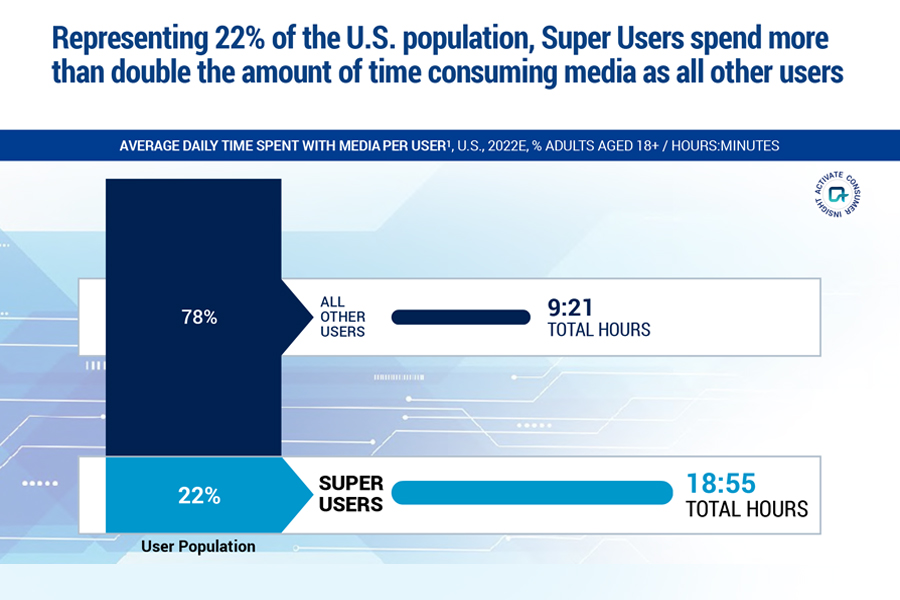
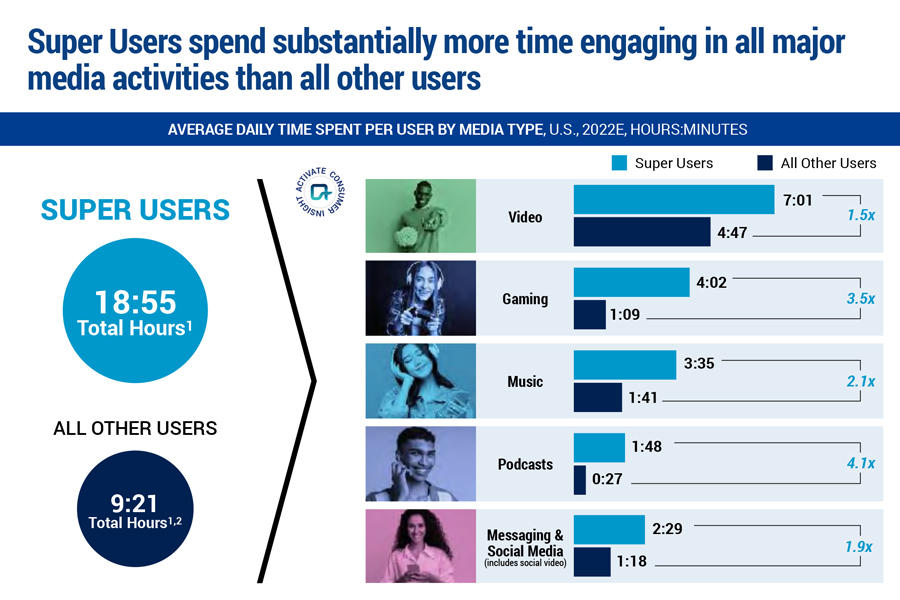
Inclined to multitask
Super Users take multitasking to the next level. Not only do they spend more time with electronics, but they excel in the art of juggling multiple activities. While watching videos and playing video games on one device, Super Users might also be busy engaging with social media on another. This makes them an unstoppable force when it comes to getting the most out of their digital experiences!

High share of dollar spend
Super Users are big spenders when it comes to media, particularly in gaming and music. Compared with all other users, Super Users’ average video spend is close to triple the amount ($76 vs $27). However, their biggest increases come from gaming and music; they’re collectively spending 12x more on games and shelling out 21x as much for tunes!
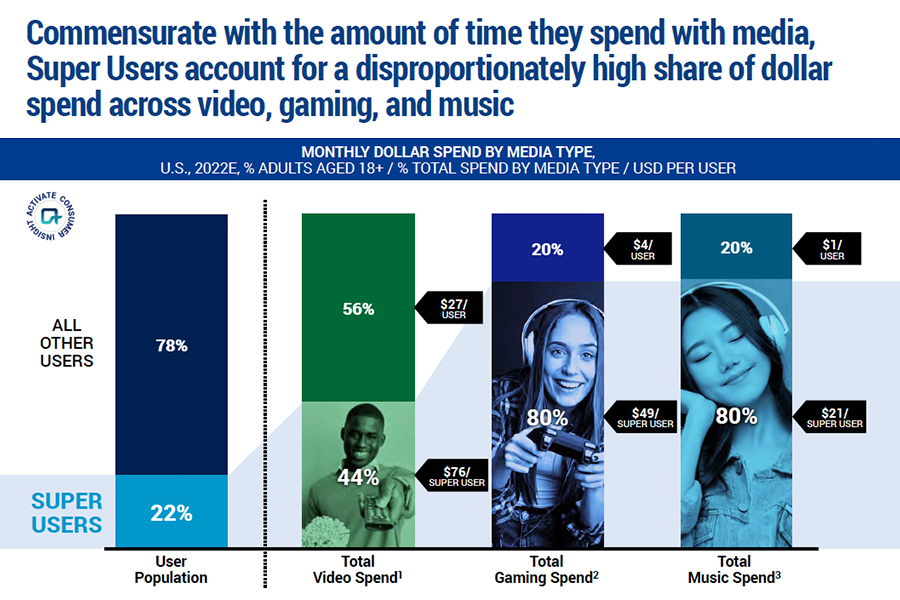
With 60% of eCommerce spend coming from Super Users, they are driving the industry forward with their enthusiasm and willingness to test out cutting-edge shopping trends like buying through social media, live streaming purchases, and trying on products virtually. Super Users are setting the tone for this dynamic industry.
Technology and media adoption
Most Super Users are brand advocates. They’re trendsetting individuals who stay ahead of the curve on media and technology. They eagerly take advantage of new products, services, and data-sharing opportunities to receive tailored ads that fit their lifestyle.
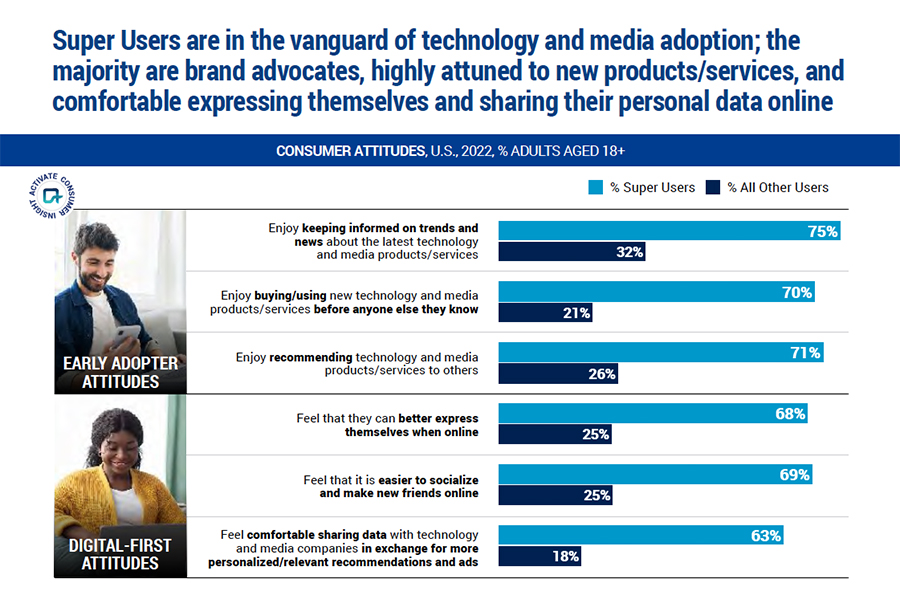
Crypto & NFTs
Super Users blaze the trail for cryptocurrency and non-fungible tokens (NFTs)! This group is five times more likely to explore, engage with, and embrace new digital-monetary technologies.
Pioneers of the Metaverse
As Metaverse usage continues to rise, Super Users are leading the way. Over 80% of these trailblazers have embraced these digital spaces within just the last year. We’re seeing accelerated interest from them as they seek out new opportunities for creativity, connections, and transactions within their favorite Metaverses. Many express interest in Metaverse experiences such as purchasing physical items to creating virtual havens. In fact, they’re 5x more interested in all things meta-related!
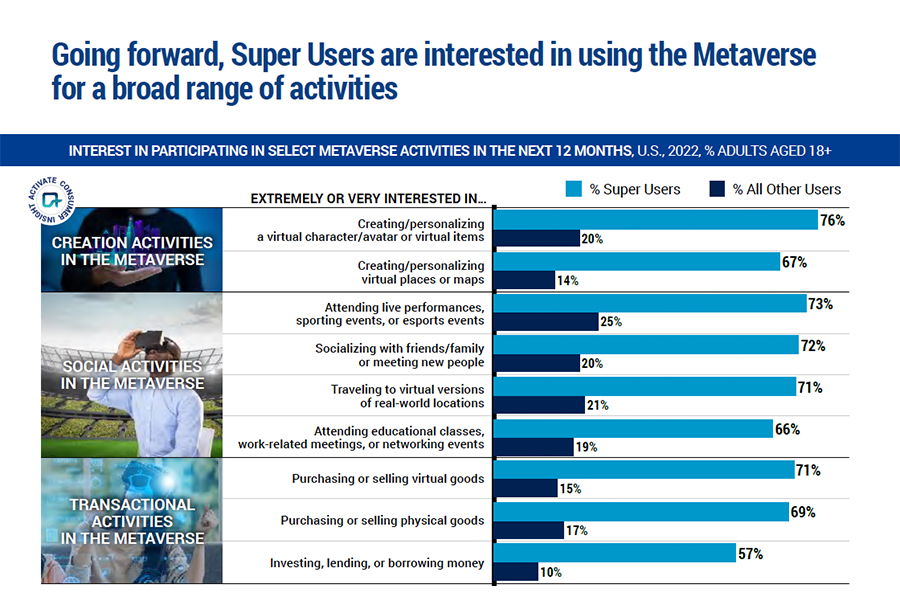
How Experian can help you identify and target Super Users
So how can you find your Super Users and include them in your marketing targeting strategy? Whether you want to build or acquire highly addressable audiences, we can help you precisely reach the right individuals and households in any channel you desire with Consumer View.
Consumer View
It all starts with data. Delivering the right message in the right place at the right time means truly knowing your prospects and customers as individuals – their lifestyles, behaviors, and shopping preferences. Consumer View data can provide a deeper understanding of your customers.
Consumer View is the world’s largest consumer database that contains over 3,900 attributes for 250 million adult consumers in the U.S. with coverage of 126 million (98%) of U.S. households. Consumer View can help you find out:
- What do your customers look like?
- What do your customers do?
- How and when should you reach your customers?
- What motivates your customers?
Modeled and syndicated audiences
We have over 2,500 pre-built audiences that are privacy-safe and built using advanced data science and the most comprehensive consumer data available. These digital audiences are readily available via major publishers, data management platforms (DMPs), advanced TV operators, and demand-side platforms (DSPs).
Our pre-built audiences can be used consistently across multiple distribution partners – making sure you can quickly find the right audience for the right campaign without having to build your own consumer personas. In addition to being available as digital audiences, our segmentation products are also available to use across all consumer touchpoints to enable consistent omnichannel campaign targeting.
There are infinite data combinations and selections we can help you with for optimal audience targeting. Using our comprehensive inventory of data, we can find even the most unusual of audiences to help you connect with new prospects. From demographics to behavioral and psychographic information, we draw on a massive base of knowledge accumulated during five decades in business.
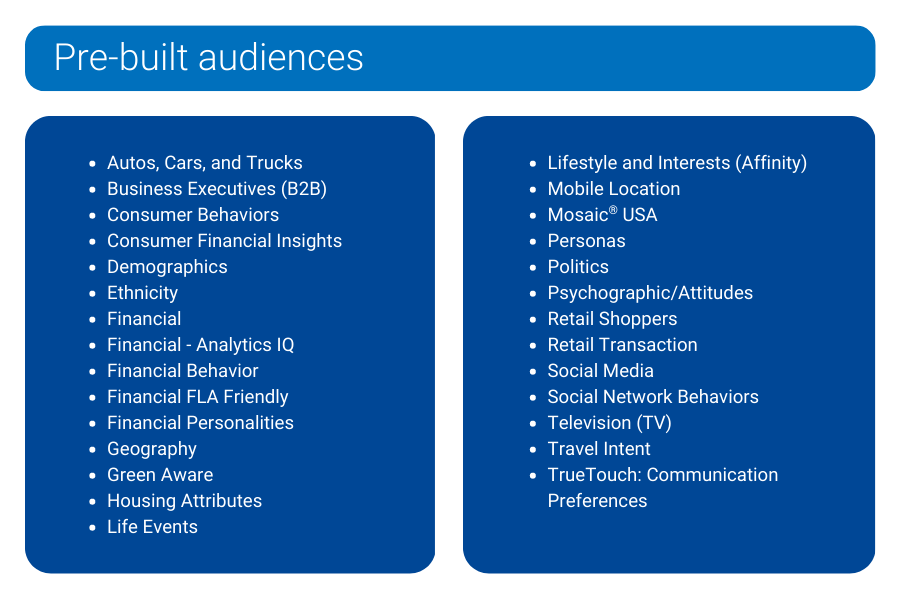
Mosaic® USA
Experian’s Mosaic® USA is a household-based consumer lifestyle segmentation system that classifies all U.S. households and neighborhoods into 71 unique types and 19 overarching groups, providing a 360-degree view of consumers’ choices, preferences, and habits. Using Mosaic lifestyle segmentation, you can anticipate the behavior, attitudes, and preferences of your best customers and reach them in the most effective traditional and digital channels with the right message in the right place at the right time.
Tailored Segmentation uses a sophisticated data-driven clustering system that leverages the 71 Mosaic types that match to first-party data like yours. Tailored Segmentation allows you to regroup Mosaic types based on the attributes you weigh as more impactful to your business. Have you designed your own segments in-house? You can apply Tailored Segmentation to those segments for deeper insights through a tailored analysis. Are you still looking for a way to segment your market even though you understand your typical best customer? Tailored Segmentation can weigh these attributes and develop a custom clustering and analysis of your market.
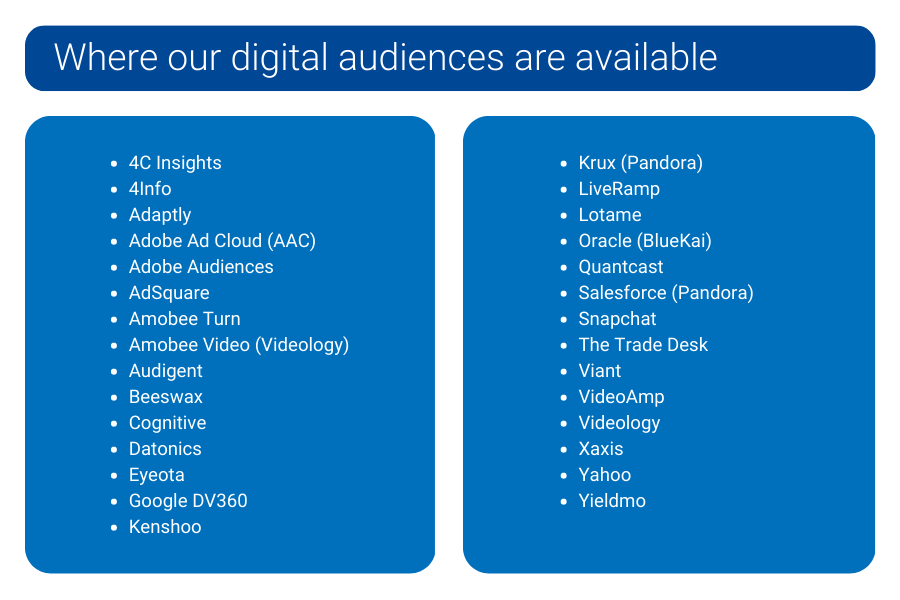
We can help you find your Super Users
Super Users are an important segment of any market. Marketers need to be able to identify them quickly and act upon their insights. Our marketing solutions provide the necessary data and analytical capabilities to easily find and target your potential Super Users for an effective marketing targeting strategy.
With Experian, you can deliver messages that are more in line with what matters to this influential group of customers. We understand how challenging it can be to find these customers and ensure they get the tailored, personalized messaging they deserve – so let us help you do just that! We can provide deep insights beyond the generic customer persona that allows marketers to look into the effectiveness of their marketing strategies from multiple angles. We want to help you gain an edge over your competitors by helping you identify, target, and engage Super Users for increased revenue growth. Ready to find your Super Users?
Sources
Activate Technology & Media Outlook 2023. Activate Consulting.
Latest posts

As part of our ongoing series which focuses on consumer and marketing trends around major holidays throughout the year, we’ve just released the Father’s Day Hot Sheet. Father’s Day gift-related searches Now that Mother’s Day has come and gone, consumers will be shifting their focus to dad. According to Experian Marketing Services’ Hitwise® online intelligence tool, searches for “Father’s Day” typically start to pop up on Mother’s Day. And searches for “Father’s Day gifts” tend to focus on affordable gift ideas that are personalized, unique and often handmade. In fact, two of the top variations of Father’s Day gift-related searches from 2014 were for “DIY” and “homemade” gifts. While many shoppers wanted the “best” gift for dad, others simply wanted something “cheap” or “last minute.” Finding a gift that dad will appreciate means looking for something that is personalized to him. As such, searches for Father’s Day gifts often contain additional information about the dad or, in many cases, grandpa. Examples commonly used in 2014 were “Christian dad,” “new dads,” “outdoorsy dads” as well dads who are wine or BBQ lovers. While many gift searches include information about the intended recipient, others mention details about the gift-giver or their relationship to the father. Among last year’s variations that included such details, nearly a third focused on gifts that were intended to be given by a “daughter.” Genderless references, such as “kids” or “children” were almost as common. Interestingly, fewer than ten percent were for gifts to be given by a “son.” About a fifth of searches included details about the age of the gift-giver (e.g.: “baby,” “toddler” or “first grader”), while others specified that the gift was to be given by the dad’s wife or girlfriend. Go, go, gadget dad! Gadgets and gizmos are always popular gifts for the techie dad. In fact, during the week immediately preceding Father’s Day last year, visits to Electronics and Appliance websites were up a relative eight percent from two weeks prior. Visits subsequently tapered off the following week. An analysis of search terms driving traffic to the Hitwise Electronics and Appliance industry the week ending June 14 versus May 13, 2014 also sheds some light on the specific items that Father’s Day gift-givers were likely to have been seeking out. Two GPS systems (“Magellan GPS” and “Tom Tom”) were among the top terms that grew search share in the weeks leading into Father’s Day last year. Likewise, “GoPro” appeared in two separate fast growing search terms. Gadgets like these and others listed in the adjacent table may be big gifts for the gadget-loving dad again this year. Gone fishin’ Fishing is a timeless family pastime enjoyed by millions of Americans. According to Experian Marketing Services’ Simmons® National Consumer Study, 28 percent of dads and 26 percent of kids ages six to 17 went fishing last year. As such, it’s no surprise that online searches related to fishing spike over Father’s Day weekend. On the Saturday before Father’s Day in 2014, searches including “fishing” were a relative 28 percent higher than they were the Saturday prior and 64 percent higher than they were the following Saturday. To better understand what kids and dads were seeking out for their fishing plans, Experian Marketing Services conducted an analysis comparing variations of “fishing” searches immediately before Father’s Day last year to those performed two weeks prior. It turns out the word “techniques” was almost 8.6 times more likely to appear in fishing-related searches just before Father’s Day than it was two weeks earlier and “tips” was four times more likely to be used. Likewise, “licenses” was used 2.3 times more frequently, which along with the higher use of “techniques” and “tips” is evidence that many would-be fishermen and women are occasional participants at best. The fact that “charter” and “cabins” were used at higher rates however suggests that other children and/or dads had something in mind beyond a lazy (and likely more affordable) afternoon at the local fishing hole. Gift items, too, like “reels,” “gear” and “tackle” were among those most disproportionately used in searches heading into Father’s Day.

Welcome! Who doesn’t like a warm welcome? Whether your customer is walking into your store or just signed up on your website to receive communications from you, she expects a warm reception. It’s important to make that first impression count. A welcome series helps the conversation open up between the customer and your brand. It sets expectations on the types and cadence of content the customer will receive. Welcome emails also garner 86 percent higher open rates than regular promotional mailings – not too shabby! In a recent webinar, Saks Fifth Avenue shared that they are constantly testing new and current programs to optimize the customer experience. As a result, they discovered that switching from batch-sending welcome emails to sending welcome messages in real time increased open, click and redemption rates significantly. Here’s an example of their welcome series: Saks’ results are consistent with Experian Marketing Services’ welcome email findings which indicate that emails triggered in real time receive up to 10 times the transaction rates and revenue per email vs. those that are batched. A welcome series has also been shown to increase retention by educating customers on new ways to use products and services they’ve purchased from your brand. These emails also can remind customers of the benefits they’ll reap from enrolling in your loyalty programs or credit card. … and welcome back Even if a customer has been welcomed and has interacted with your programs, a day may come when the customer goes silent. Reactivation campaigns are an effective way to get them to re-engage. Naturally, it’s important to target your dormant customers in a variety of channels so you can reach them more effectively. Maybe you’re wondering why I jumped from the warmth of a welcome series right into reality of needing a reactivation campaign. The reason? Marketers need to understand where a customer is in their lifecycle and come full circle with customers if they have parted ways. Marketers can pique the interest of a returning customer by telling them what’s new and reintroducing them to their brand. Carnival® Cruise Lines, for example, sends a welcome-back email that features the newest social networks, offers and deals its customers can take advantage of immediately. At the end of the day, customers expect to receive relevant and engaging messages throughout their entire relationship with a brand. Customer life cycle programs deliver just that. If you’re interested in learning more about welcome campaigns, waitlist/back-in-stock programs and other remarketing strategies, check out our webcast,

In a previous blog entry, Ordering sushi and a lesson in embracing the contextual marketing mindset, I showcased a fictitious scenario that required complex data point integration to pull off. These kinds of programs can seem overwhelming given the three barriers that many organizations face when embarking on their contextual marketing journey: Marketing sophistication A brand’s own conventional mindset and the programs that support it Actionable data Lack of clean and accurate data that prohibits real-time “on the fly” interactions Technology Disparate systems that are unable to link information across repositories, channels and interactions; inability to automate interactions in real-time Regardless of the barriers, there are ways you can show customers you’re listening and provide contextual messages without “boiling the ocean.” Take, for example, the recent viral blue/black vs white/gold dress debate. As the conversation spread throughout Facebook and Twitter, brands like Dunkin’ Donuts and Tide tweeted these contextual messages: The tweets did not go unnoticed as thousands of followers retweeted, commented and favorited these messages. The contextual elements used in these messages — channel preference and breaking/relevant news — are easily accessible to any brand. While the brands had to act swiftly, executing these messages circumvented the three barriers listed above. On the flip side, addressing the barriers can allow a brand to build more sophisticated, targeted contextual messages, as shown in the below example. Here, Experian Marketing Services and technology partner Movable Ink helped Finish Line deliver this sale announcement that adjusts based on the date and time the customer opens the email. The message remains relevant via a countdown clock during the run of the sale, a “warning” when it’s about to end and an alternative message after the sale ends — all of which ensures that the message is relevant regardless of when it’s opened by its intended recipient. And combining more contextual data points, such as location and stock, Finish Line includes the countdown, a local map to the customer’s nearest location and up-to-the-minute inventory of available sizes. Contextual marketing enables modern enterprises to engage in customer-centric conversations that — like any meaningful relationship — deepen across time and future points of engagement. This is particularly true in an era when consumers are overwhelmed by untargeted and disruptive marketing messages. By contrast, contextual marketing is designed to seamlessly and usefully merge into the customer’s daily activity. Want to know more and how to get started? Download the eBook From campaigns to context: Making the move to contextual marketing.